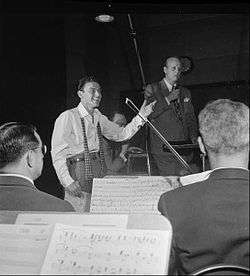Axel Stordahl
| Axel Stordahl | |
|---|---|
|
Axel Stordahl at rehearsal with Frank Sinatra, Liederkranz Hall, New York, c. 1947. | |
| Background information | |
| Born |
August 8, 1913 Staten Island, New York |
| Died |
August 30, 1963 (aged 50) Encino, California |
| Associated acts |
Tommy Dorsey Frank Sinatra |
| Notable instruments | |
| trumpet | |
Axel Stordahl (August 8, 1913 – August 30, 1963) was an arranger who was active from the late 1930s through the 1950s. He is perhaps best known for his work with Frank Sinatra in the 1940s at Columbia Records. With his sophisticated orchestrations, Stordahl is credited with helping to bring pop arranging into the modern age.[1]
Early years
Stordahl was born in Staten Island, New York to Norwegian immigrant parents. He began his career as a trumpeter in jazz bands which played in several dance bands around Long Island and the Catskills during the late 1920s and early 1930s. He also began arranging around this time, and in 1933 he joined Bert Bloch's orchestra in both capacities. Over the next couple of years, Stordahl sang on the side in a vocal trio dubbed the Three Esquires.[2]
Big bands
In 1935, he joined Tommy Dorsey's new orchestra and soon became the band's main arranger. In January 1940, Sinatra joined the group as vocalist, and it became apparent that Stordahl's arrangements were particularly well suited to the singer's voice.[3]
Recordings
In January 1942, Stordahl arranged Sinatra's very first commercial solo recordings (which appeared on the RCA Records sub-label Bluebird), and when Sinatra left Dorsey seven months later to go solo, Stordahl went with him. In the subsequent decade, Sinatra cut close to three hundred sides for Columbia Records, of which three quarters were arranged by Stordahl. In addition, Stordahl provided the orchestral backings, both as arranger and conductor, for several hundreds of songs in various Sinatra radio shows. He was the credited orchestrator for the 1945 Academy Award-winning picture Anchors Aweigh which starred Frank Sinatra and Gene Kelly.[4]
Stordahl was admired for his skills in framing Sinatra's voice, creating a soft, opulent sound with swirling strings, understated rhythms and woodwinds. He was one of the first American arrangers to tailor his work to the vocal qualities of a specific singer. When Sinatra moved to Capitol Records in 1953, Stordahl arranged his first recording session there (which produced four songs). From then, however, Sinatra worked extensively with Nelson Riddle, who cultivated his jazz-oriented qualities, as well as Gordon Jenkins, Billy May, Don Costa, Neal Hefti, Quincy Jones, and others.
Stordahl went on to work with such singers as Bing Crosby, Doris Day, Eddie Fisher, Dinah Shore, and Dean Martin, among others. Although best known as an arranger, Stordahl also composed a number of songs of which Day by Day with music by Axel Stordahl and Paul Weston and lyrics by Sammy Cahn, is the best known.
In 1961, Sinatra returned to collaborate with an already ailing Stordahl for his final Capitol album, Point of No Return.
Television
Stordahl worked with Fisher's television program for four years[5] and composed and orchestrated the theme to the television sitcom series McHale's Navy.[6]
In 1953, was signed to do a twice-weekly 15-minute program on NBC television with Coca-Cola as sponsor. Audio of the program was recorded and broadcast on a delayed basis on NBC's radio network.[7]
Radio
In addition to his work as conductor on Sinatra's radio program,[8] Stordahl conducted the orchestra on Eddie Fisher's Coke Time show[9] and worked on the radio version of Your Hit Parade.[5]
Personal life
Stordahl married singer June Hutton (of the Pied Pipers) in 1951.
Honors
In 1967, the Los Angeles chapter of the National Academy of Recording Arts and Sciences established a scholarship in Stordahl's memory at the University of California, Los Angeles. Only graduate students were eligible for the $300 scholarship through the music department.[10]
Death
Stordahl died August 30, 1963, at the age of 50 of cancer in Encino, California.[11] He was interred in the Forest Lawn Memorial Park in Glendale, California and was survived by his wife, a son and a daughter.[11] His wife June Hutton, who died in 1973, is interred next to him.[12][13]
Selected compositions
- I Should Care (1945)
- Day by Day (1946)
- Ain'tcha Ever Comin' Back (1947)
- Night After Night (1949)
- Meet Me at the Copa (1950)
References
- ↑ Axel Stordahl Biography (Yahoo! Music FoxyTunes)
- ↑ Axel Stordahl, biography (The encyclopedia of big band, lounge, classic jazz and space-age sounds) Archived January 1, 2011, at the Wayback Machine.
- ↑ Tommy Dorsey And His Orchestra: The Early Years (Michael P. Zirpolo)
- ↑ The Men Behind the Music – Axel Stordahl (The Palomar)
- 1 2 "Axel Stordahl, Composer, Dies". Traverse City Record-Eagle. August 31, 1963. p. 3. Retrieved July 16, 2015 – via Newspapers.com.

- ↑ Huey, Steve. Biography of Axel Stordahl at AllMusic. Retrieved 2012-04-17.
- ↑ "Stordahl AM-TV Seg for Coca-Cola". Billboard. April 4, 1953. p. 3. Retrieved 17 July 2015.
- ↑ Hilton, Chuck (October 18, 1944). "On The Beam". The Mason City Globe-Gazette. p. 2. Retrieved July 16, 2015 – via Newspapers.com.

- ↑ "Senator Anderson Interview Guest". Brownwood Bulletin. June 29, 1953. p. 1. Retrieved July 16, 2015 – via Newspapers.com.

- ↑ "Stordahl Grant Is Set Up by NARAS". Billboard. June 24, 1967. p. 6. Retrieved 17 July 2015.
- 1 2 "Axel Stordahl Dies In California". The Times Record. August 31, 1963. p. 19. Retrieved July 16, 2015 – via Newspapers.com.

- ↑ "Axel Stordahl". Find a Grave. Retrieved October 5, 2015.
- ↑ "June Hutton". Find a Grave. Retrieved October 5, 2015.
External links
- Axel Stordahl at the Internet Movie Database
- Photograph of Axel Stordahl
- "Classical Music" entry for Axel Stordahl at AllMusic. Retrieved 2012-04-17.
- Axel Stordahl at AllMovie
